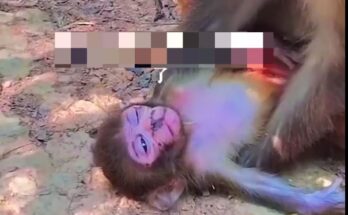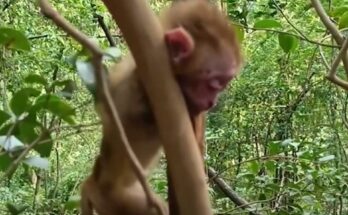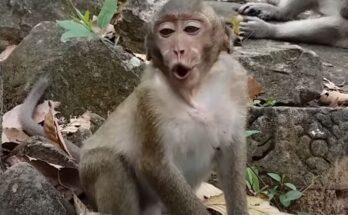Life in the animal kingdom is often harsh, and the story of a baby monkey born with a disability can be particularly poignant. From the moment it enters the world, the challenges it faces are immense. Unlike human societies, where extensive care and support systems can exist, animals rely on their instincts, physical abilities, and social structures for survival. A baby monkey born with a disability is immediately at a disadvantage in this demanding environment.
Early Challenges
From the start, a baby monkey with a disability struggles to keep up with its peers. Whether the disability affects its mobility, vision, or cognitive functions, it hinders its ability to navigate its environment, forage for food, and interact with the troop. For instance, a monkey with a limb deformity might find it difficult to cling to its mother, a behavior crucial for safety and nourishment in the early weeks of life. The mother, depending on her temperament and the troop’s culture, may face difficulty caring for a baby that requires extra attention.
Other members of the troop may respond differently. In some primate groups, the mother’s instinct to protect her young can overcome any obstacles, and she may carry the baby with her despite its struggles. However, in some cases, the troop may reject the infant, seeing it as a weak link that could attract predators or slow the group’s movement. Such rejection poses a severe threat to the infant’s survival.
Social Implications
Monkeys are highly social creatures, and their well-being depends heavily on their relationships within the troop. A disabled monkey often finds it difficult to engage in typical play behaviors, which are crucial for developing social bonds and learning skills. This exclusion can lead to isolation, making the young monkey even more vulnerable. Without strong social ties, it may not receive help in times of need or protection from predators.
However, stories from both the wild and captivity reveal that compassion exists in the animal kingdom. In some instances, members of the troop, especially siblings or older females, step in to care for the disabled baby. These acts of altruism demonstrate the complexities of primate social structures and their capacity for empathy.
Survival and Adaptation
For any animal with a disability, survival depends on its ability to adapt. A baby monkey might develop alternative ways to climb, move, or forage, compensating for its limitations. Observers have noted cases where disabled monkeys grow into adulthood, finding unique ways to contribute to their troop. For example, they might become adept at finding hidden food sources or serve as a lookout while others forage.
In sanctuaries or rescue centers, disabled monkeys have a better chance of survival. Here, they receive care tailored to their needs, including medical attention, a safe environment, and opportunities to socialize with other animals. These centers play a crucial role in improving the lives of monkeys that would otherwise struggle in the wild.
A Tale of Resilience
The story of a baby monkey with a disability is a tale of resilience against overwhelming odds. While the challenges are immense, such stories also highlight the beauty of compassion, adaptation, and the will to survive. Whether supported by its troop or human caregivers, the journey of a disabled monkey serves as a reminder of the universal struggle for life and the power of perseverance.


